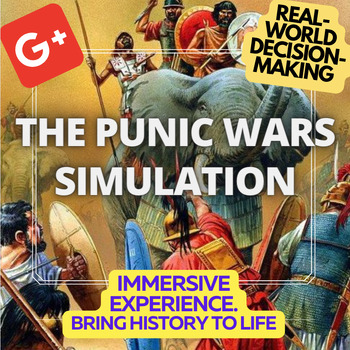The Punic Wars Simulation -- Can You Solve this Crisis?
- Word Document File
Description
Hi, friends and welcome!
I'm so excited to share this resource with you!! This is my immersive, real-world, hands-on Second Punic War Simulation. This simulation aims to immerse students in the historical context of the conflict between Rome and Carthage, and challenge them to make critical decisions as military and political leaders to shape the outcome of the war.
To learn more about my simulations and their structure, please watch this short video here.
In essence, students are placed into small groups and have to make real-world and historical decisions, including:
1) Scenario 1: Hannibal's Invasion of Italy
Scenario Description: Your group represents Carthage during the Second Punic War. Hannibal Barca, the brilliant Carthaginian general, has successfully crossed the Alps into Italy, catching Rome off guard. As Carthaginian leaders, you must navigate the challenges of maintaining supply lines, securing alliances, and making critical decisions to capitalize on Hannibal's invasion.
2) Scenario 2: Scipio Africanus and the Counterattack
Scenario Description: Your group represents Rome during the Second Punic War. The renowned Roman general Scipio Africanus has emerged as a formidable leader, determined to turn the tide against Carthage. As Roman leaders, you must navigate the challenges of regaining control in Italy, consolidating alliances, and making critical decisions to counter Hannibal's invasion.
3) Scenario 3: Battle of Cannae
Scenario Description: Your group represents either Carthage or Rome during the Second Punic War. The battle of Cannae, one of the most significant engagements in the war, is about to take place. As military commanders, you must make critical decisions to outmaneuver and defeat your opponent in this decisive battle.
4) Scenario 4: Diplomatic Negotiations and Treaty
Scenario Description: Your group represents either Carthage or Rome during the Second Punic War. Both sides have experienced significant losses and seek a diplomatic solution to end the conflict. As diplomats and negotiators, you must make critical decisions to secure a favorable treaty that preserves the interests of your respective side.
I love to engage my students in simulations because they provide a dynamic and immersive learning experience that goes beyond the pages of a textbook. By stepping into the shoes of historical figures and making decisions, students develop a deeper understanding and empathy for the challenges, complexities, and human stories of the past. My simulation foster critical thinking skills, encourage teamwork and collaboration, and allow students to explore different perspectives and outcomes. Through such interactive experiences, students forge a deeper engagement with history, realizing that the decisions made by individuals and societies in the past have far-reaching consequences that shape the present and future.
This resources includes 11-pages of content:
- Clear instructions for the teacher
- Ample context about the Second Punic War
- Scenario sheets for students



